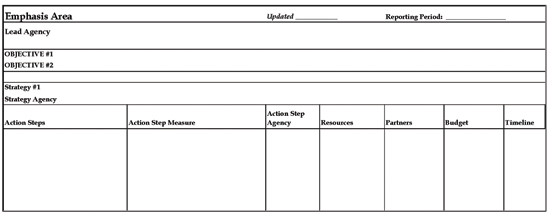Chapter 4
Emphasis Area Action Plans
SHSP emphasis area action plans provide a road map to give stakeholders and partners direction. While emphasis areas may be defined differently, all can be supported by action plans that provide specifics such as performance measures, funding sources, project-level detail, and evaluation criteria for assessing outcomes. Action plans turn SHSP concepts and ideas into a reality that saves lives and prevents injuries.
During SHSP development, States identified emphasis areas and developed strategies to improve safety by using data to focus on the most serious transportation safety problems. Action plans describe how the identified strategies will be implemented. For instance, if the objective is to reduce lane-departure crashes by 10 percent by the end of fiscal year 2012, the strategies would detail how the State intends to meet the objective. One strategy could be to identify the top 10 hazardous lane-departure locations in the State and reduce lane-departure crashes at those locations while another strategy could be to install rumble strips on principal arterials throughout the entire State. The action plan details how each strategy will be achieved, i.e., obtain base line data; conduct road safety audits; etc.
Action plans include data needs, resources (staff, equipment, materials, and training), a timeline, whether legislative action is required, what agency or organization is responsible, a budget, performance and process measures, and an evaluation plan. Decision-makers can use the information in the action plans to commit the resources and people needed for implementation. The level of detail required depends on the strategy’s complexity, size, scope, and the number of participating agencies. Process and performance measures form the basis for monitoring and evaluation. To promote accountability throughout the action planning process, some States assign agency/organization responsibilities for each emphasis area, objective, strategy, and action step. Some States define their action plans in terms of work tasks, inputs/outputs, and agency roles, using project management techniques, including Gantt charts, to manage the implementation process.
After enduring the often challenging SHSP development process, some stakeholders experience strategic planning fatigue. Developing action plans may seem detailed and tedious, but the step cannot be ignored. The hard work and effort put forth during SHSP development becomes meaningless without the organizational and institutional framework of the action plan that cultivates and enhances the collaboration and cooperation essential to success.
Action plans eliminate guesswork, prevent shot gun approaches, and focus resources where they are most needed. They create a link between the goals and objectives of the SHSP and the prioritization and selection of projects within existing transportation planning and programming activities (e.g., HSPs, HSIPs, CVSPs, S/TIPs, etc.). SHSP action plans can be posted on the Internet to promote transparency and offer opportunities for additional stakeholders to participate in or support SHSP implementation.
The action planning process emphasizes collaboration, communication, cooperation, and agency coordination. Successful approaches to action planning may vary. Some States develop uniform processes across emphasis areas and others allow flexibility in how individual emphasis areas teams are managed. Regardless of the approach, all have involved active participation from emphasis area team members and often a facilitator to assist the team in reaching consensus on the action plan elements. Emphasis area team leaders should work closely with the facilitators to ensure the process to develop action plans does not get bogged down. States should also consider developing a matrix or tool to focus the discussion and ensure the necessary information is collected. Figure 4.1 illustrates an example action planning tool.
Figure 4.1 Action Planning Matrix Steps

Some States coordinate SHSP action plans with existing agency safety plans and programs (i.e., HSP, CVSP, HSIP). Emphasis area action plans can and should be incorporated into the work plans of existing task forces or committees. This approach avoids duplication, promotes buy-in from the implementing agencies, and provides an opportunity to leverage existing programs and resources.
Action plans are living documents that should be revisited and amended as necessary. Teams can add, remove, or revise strategies and action steps over time to ensure the plan remains relevant. For instance, dramatic changes in data may warrant a fresh look at all SHSP elements, including action plans. Waiting for next SHSP update cycle to make these changes can result in losing the momentum needed for successful implementation.
Some action plan steps are easier to implement than others. Advocating legislative strategies to advance road safety may be politically sensitive. Some States omit them completely, while others make attempts to address these strategies through appropriate channels. States successfully addressing legislative strategies involve key partners, such as legislative officials and private organizations in the effort. In some instances, a legislatively mandated task force is formed to examine laws pertaining to specific emphasis areas, such as impaired driving. In this case the task force can develop the strategies and action plans for the SHSP. Involving these parties up front ensures everyone is working from the same information and avoids conflicting programs and messages.
Action plans involving changes to policy and design standards can be complicated as well. Incorporating standards for cable median barriers, rumble strips, etc., into a State’s design standards or policies, may be difficult to address in action planning. In these cases, the action plan may point to a series of steps leading to the development of new standards, without defining the specific standards or policies. Once again, involving the appropriate partners in the process provides greater opportunity for adoption of the strategies.
The following guide can be used to develop action plans. The list can be tailored to individual State and local needs and conditions.
Action Planning Guide
Establish an Action Planning Framework and Evaluation Approach
|
- Define the goals for the SHSP – the reasons for the plan.
- Define the measurable objectives – what the plan will accomplish.
- Determine the performance measures that will be used to evaluate the plan.
- Determine the measurement method for each performance measure.
|
Develop the Action Plan
|
- Determine the strategies for achieving each of the objectives.
- Determine the action steps for accomplishing each strategy.
- Determine the process measure or performance indicator for measuring progress.
|
Identify Resource Requirements
|
- Agencies whose cooperation and coordination is required.
- Funding and personnel.
- Data and information.
- Equipment, materials, and training.
- Schedule.
- Steps that require legislative approval.
|
Develop a Detailed Budget
(many States include this step as part of the specific plan/program processes described in Chapter 5):
|
- Provide detailed budget information by task.
- Separate information by funding source and agency/office.
|
Tracking and evaluation are discussed in Chapter 7; however, evaluation design is a critical element of an action plan and should be developed before the project starts to ensure activities are directly linked to expected outcomes and baseline data are collected.
Key Emphasis Area Action Plan Strategies:
- Develop detailed action plans for each strategy in your SHSP.
- Identify a facilitator to assist emphasis area teams in achieving consensus on action plan elements.
- Identify performance measures as a basis for monitoring and evaluation and assign responsibilities to support accountability.
- Assign responsibilities to support accountability.
- Review and amend action plans as you proceed with implementation.
- Provide emphasis area team members with a copy of the IPM.
Checklist
Answering these questions will help stakeholders review their SHSP action planning process and identify opportunities for improvement.
- Does your State have action plans for all SHSP emphasis areas and strategies?
- Does your State have multidisciplinary action planning teams?
- Is someone assigned to coordinate and document all the actions plans and track progress?
- Are the action plans available to all the stakeholders?
- Are projects and activities identified in the action plans?
- If your State’s SHSP includes strategies that require changes in legislation, policies, or design standards, are the proper legislative officials involved in the action planning process?
<< Chapter 3 Chapter 5 >>
|
|





